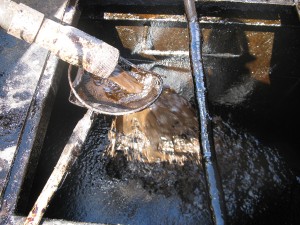US shale oil rebound shakes OPEC

Scott Sheffield, CEO of Pioneer Natural Resources, shale oil, ShaleMag.com photo.
How low can the costs of US shale oil production go?
By Ross McCracken, Platt’s Managing editor, Energy Economist
Even with oil prices hovering around the $50/b mark, the US rig count has increased rapidly while E&P companies continue to record substantial reductions in well drilling costs. The increase in new well oil production per rig demonstrates the extraordinary gains the shale drillers have made.
In April 2014, new well oil production per rig on the Bakken was recorded at 492 barrels and on the Eagle Ford at 463 barrels.
In April this year, the figures are 1,067 barrels and 1,448 barrels, respectively. Moreover, US E&P companies remain confident they can continue to eke further efficiencies out of their seemingly ever-evolving factory-mode production processes.
However, not all is well. A large part of reductions in well costs came about as a result of the crunch in drilling activity post-2014, when the oil price fell from its heady three-digit heights.
The lack of demand for drilling resulted in over-capacity in the oil services sector, which led to a fall in the prices charged for oil services and also a contraction in the sector’s capacity.
As activity rebounds and the rig count rises, the oil services sector will also start to tighten and, indeed, US oil services costs are now forecast to rise about 20 per cent this year. Even if US drillers can continue to deliver efficiency gains, they will have to battle this countervailing price pressure.
Much depends on the oil services sector’s ability to re-establish its former capacity, but there is little short-term motivation to do so, as service providers will be keen to re-establish the margins they formerly enjoyed.
As a result, forecasts that US crude production will return to the record levels of the 1970s in 2018 may well only be realized if oil prices move above $60/b.
This, in turn, would appear to depend on an extension of OPEC’s production cuts into the second half 2017, and probably beyond, a prospect which will test the resolve of the organization’s non-OPEC partners.
The joy of being an OPEC member is to exercise market power through collective action, attempting to maximize the volume versus price equation.
The joy of being a non-OPEC member is to hoover up the free rider oil price benefits of OPEC’s restraint. Currently, that pleasure is accruing predominantly to US producers, which get to maximize volume at better prices.
The extraordinary costs reductions achieved in the US have another consequence. They will be exported to Argentina, where momentum and investment levels, led by some major US companies, is growing on the giant Vaca Muerta shale play.
The challenges are big and the political risk relatively high but, in terms of production costs and reaching factory-mode production, Argentina should benefit hugely and comparatively rapidly from decades of US innovation in shale production techniques.
As a result, OPEC and its non-OPEC associates may find — in the not too distant future — that the return to the exercise of market power through production restraint will result in competition from not one but two major shale producing centers with implications as much for LNG markets as oil.
More shale production means a further rise in the investment responsiveness to prices, and a further shortening in the time taken to turn investment into production. This is the crux of the matter.
OPEC previously exercised market power in an environment in which new sources of shale oil supply were frontier, had long lead times, and high costs — crucially higher costs than their own production. That meant output restraint could deliver higher prices.
That environment has changed. Cost gains made by US producers mean shale oil is no longer a frontier and, more importantly, it is no longer high cost.

Ph: 432-978-5096 Website: www.mapleleafmarketinginc.com








